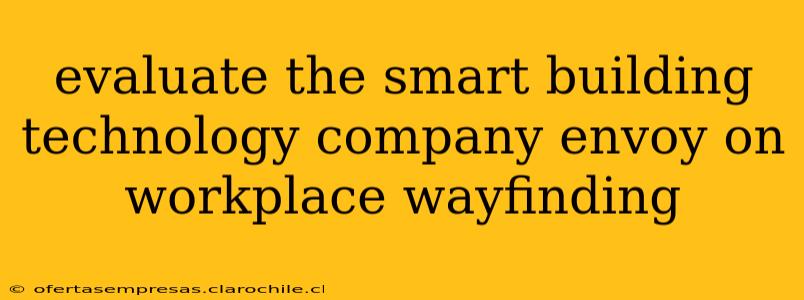Envoy is a well-known smart building technology company offering a suite of solutions designed to streamline workplace operations. One key feature gaining traction is its approach to workplace wayfinding. This article dives deep into Envoy's wayfinding capabilities, evaluating its strengths, weaknesses, and overall effectiveness in improving the employee experience. We'll also address some frequently asked questions surrounding this technology.
What are Envoy's Wayfinding Features?
Envoy's wayfinding capabilities are integrated within its broader workplace management platform. It doesn't stand alone as a dedicated wayfinding app, but rather works seamlessly within the existing Envoy ecosystem. Key features include:
- Interactive Floor Plans: Envoy integrates digital floor plans, allowing employees to easily navigate their office space. These plans are often customizable, allowing businesses to reflect accurate desk layouts, meeting room locations, and other key points of interest.
- Room Booking Integration: Wayfinding is tightly coupled with Envoy's room booking system. Once a meeting room is reserved, the app can provide clear directions to the room, reducing wasted time searching.
- Desk Finding: In hot-desking environments, Envoy can help employees locate available desks, often incorporating real-time occupancy data for maximum efficiency.
- Visitor Management Integration: Envoy's visitor management system can leverage wayfinding to guide visitors to their desired location within the office. This helps streamline the check-in process and improves the overall visitor experience.
- Mobile Accessibility: All of these features are accessible through Envoy's mobile app, making navigation intuitive and convenient for employees.
How Effective is Envoy's Wayfinding in Practice?
The effectiveness of Envoy's wayfinding solution depends heavily on several factors:
- Accuracy of Floor Plans: Maintaining accurate and up-to-date floor plans is crucial. Any discrepancies between the digital map and the physical office can lead to confusion and frustration.
- Integration with Other Systems: The seamless integration with room booking and visitor management is a significant strength, but only if these systems are also well-maintained and accurately reflect the office's layout.
- User-Friendliness of the Interface: The mobile app needs to be intuitive and easy to use. A complicated or confusing interface can negate the benefits of the wayfinding technology.
- Office Size and Complexity: Envoy's wayfinding is likely more effective in smaller, simpler offices. In larger, more complex buildings, the accuracy and efficiency of the system might be challenged.
While generally well-regarded, some users report minor issues with occasional inaccuracies or glitches in the system. Regular updates and maintenance are critical for ensuring the system's ongoing effectiveness.
Is Envoy's Wayfinding Suitable for All Office Sizes?
While Envoy can technically be used in offices of various sizes, its effectiveness scales differently. In smaller offices, the benefits are more readily apparent and easier to implement. Larger, more complex offices might require more significant effort to ensure the floor plans are accurately represented and the system integrates seamlessly with other workplace technologies. In very large campuses, Envoy's wayfinding might be just one component of a larger, more comprehensive navigation system.
What are the Alternatives to Envoy's Wayfinding Solution?
Several other companies offer comparable workplace wayfinding solutions, some integrated into broader workplace management platforms and others as standalone applications. These often utilize different technologies such as Bluetooth beacons or QR codes to enhance accuracy and provide real-time location updates. Researching these alternatives is important to find the best fit for your specific needs and budget.
Does Envoy Wayfinding Offer Real-time Updates?
Envoy's wayfinding capabilities, while not always explicitly advertised as "real-time," strive to reflect current office conditions. The degree of real-time accuracy depends heavily on the integration with other systems (like room booking and desk occupancy sensors). While it may not provide second-by-second updates, it aims to offer relatively up-to-date information to guide employees and visitors efficiently.
Conclusion:
Envoy's contribution to workplace wayfinding is a valuable addition to its suite of smart building tools. Its integration with other systems makes it a streamlined solution for many businesses. However, the success of its implementation hinges on accurate data, regular maintenance, and a user-friendly interface. Consider the size and complexity of your office and compare its functionality to alternative solutions before making a decision. Thorough research and planning are key to maximizing the benefits of any wayfinding technology.
